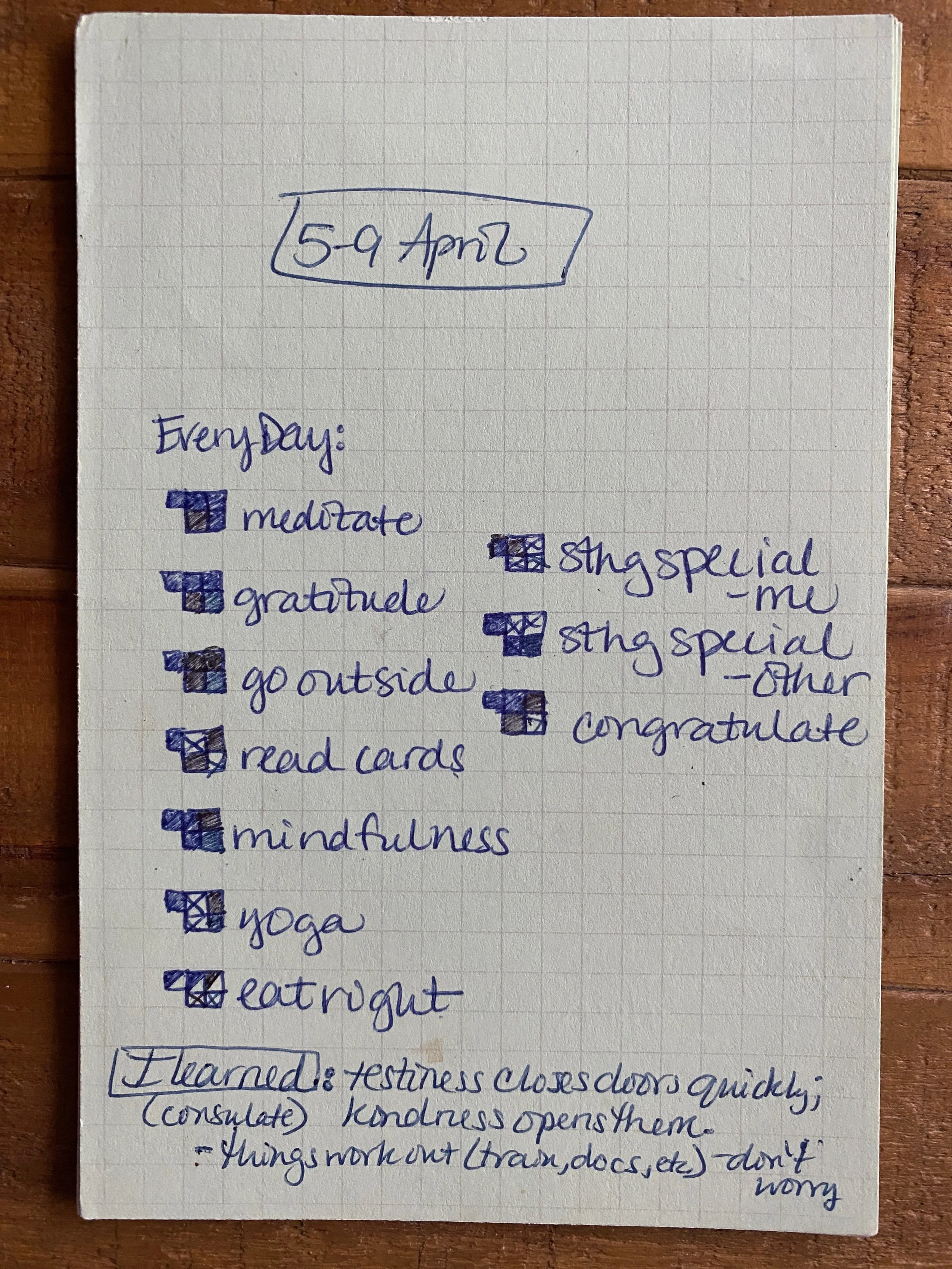Turn Toward the Light
I’m delighted to share a piece that Myra Goodman of Quest for Eternal Sunshine wrote about the beginning of my mindfulness journey.
When Myra and I spoke about my experiences 16 years ago, I was surprised and amazed by how much my approach in therapy and mindfulness teaching today has its roots in that time of unhappiness and growth.
These things changed my life back then, and they continue to be true: The miracle of mindful awareness, which makes visible the invisible patterns we have been living. The power of small, almost microscopic, choices and shifts. The hope offered by neuroplasticity—we can play a role in changing our brains!
All of this has been so positively impactful in my own life, which has compelled me to share it with others. As you’ll see below, I’ve been lucky to collaborate with Quest for Eternal Sunshine for the past three years to create accessible, free mindfulness resources…with more to come! I hope you’ll give them a try.
(Written by Myra Goodman, originally published on Quest for Eternal Sunshine)
Two inspirations converged to lead this post I’m sharing today about turning towards the light.
The first is that I just finished listening to the Audible version of Quest for Eternal Sunshine: A Holocaust Survivor’s Journey from Darkness to Light for the very first time all the way through. Previously, I’d only heard it in small sections, focused solely on reviewing it for errors as it was submitted chapter by chapter by the narrator I’d hired—and that was six years ago.
Hearing the story read aloud—including my own voice narrating a passionate introduction and epilogue—allowed me to experience it anew. I was swept up by waves of intense emotion, overcome with awe for my father’s triumphant journey from the deepest darkness to dazzling light, and bursting with revelations.
The second inspiration came from an enlightening conversation I had with Katie Dutcher while my father’s journey was so present in my mind. As a meditation teacher and certified Mindful Outdoor Guide whose interests are closely aligned with my own, Katie and I have collaborated on many of my favorite Quest for Eternal Sunshine free Tools for Healing resources.
Over the seven years we’ve been working together, Katie has become an Associate Marriage and Family Therapist, and is in the process of becoming a certified qigong instructor in my qigong teacher’s program, which has made her an even more essential resource to me.
Talking to Katie, I was surprised to discover that despite the vast differences in their histories, her journey reminded me a lot of my father’s. Spurred on by their determination to put an end to deep suffering, they were both relentless—and successful—in their efforts to retrain themselves to live more joyfully and peacefully.
For my father—after having been imprisoned by unrelenting fear and depression for decades after World War II—when he hit middle age, it was as if an alarm clock had gone off in the recesses of his mind. Suddenly, he could no longer stay resigned to what he’d previously accepted as his unalterable fate. He wrote, “I knew my life was not what it could or should be, and that something needed to change. I began to revolt against my unacceptable state of existence. I had to find liberation.”
Katie’s alarm went off when she was 29. She’d been living in Morocco for three years, was newly married to a Moroccan man, and teaching English as a Second Language. “Initially I was happy,” she told me. “But suddenly all my good friends moved away, and I felt lonely and like an outsider. I was trapped in a job I didn’t like for at least another year.”
According to Katie, “I was grouchy, irritable, and incredibly negative—complaining about my job and picking fights with my dear husband. I had always considered myself to be a positive person, but I now I couldn't recognize myself. I knew something needed to change.”
Katie began Googling questions about how to be happy. Over and over, she read that mindfulness and meditation were something many happy people did, so she began to meditate regularly for short periods of time, which she found very helpful.
Katie also read book after book. One in particular became her lifeline: Positivity, by Barbara L. Fredrickson. Its focus is on creating conditions that lead to “upward spirals” that help you flourish—as opposed to “downward spirals” that lead to negative outcomes. “I knew that I was nowhere close to flourishing,” Katie said. “Just the thought of flourishing sounded amazing.”
The following passage from Positivity is Katie’s favorite. I love it, too, because it encapsulates so much of my father’s strategy for healing:
Seek out and savor all manner of goodness, beauty, and excellence. Treasure these moments and you’ll unlock recurrent waves of gratitude, awe, inspiration, and more. Become like a plant and turn toward the light, in all its spiritual, earthly, and human forms. Feed on it.
The more you train your eye, mind, and heart to the positivity in your life, the more of it you’ll find. Remember that the intensity of your positivity matters far less than its relative frequency… Gratuitous negativity, which once grew out of control, will no longer control your destiny.
Katie diligently followed Fredrickson’s directions about how to generate upward spirals. “I created a whole folio filled with little things that I would do every day. Little by little, it was these small acts that began to make a big difference.”
Katie’s homemade happiness project binder
Here are just a few of the many things Katie put on her list to infuse joy or something new into her life:
First thing when I see my husband, I’m going to smile.
Instead of taking the school van to work, I’m going to walk there along the circuitous trail through the rocky meadow.
I’ll spend time looking at flowers on my way home from work.
I’ll refrain from complaining, and not participate when others are complaining.
I’ll try to make my husband laugh.
I’ll get up from my desk every hour.
Soon things began to click, and Katie kept having ideas that made her feel more strongly connected to nature and more positive about the people in her life. She said, “For example, one day while walking to work, I decided to pick a bouquet and give it to the person who worked in the office. I was surprised by how good it felt—the combination of my enjoyment picking the flowers and witnessing her gratitude in receiving the bouquet. I began to come up with other small ways to spark delight.”
Looking back, Katie realizes that her “happiness project” was based on the very same principles she teaches today. “I’m always encouraging clients to make many tiny shifts throughout their day. Great progress happens with this little-by-little approach. Remembering to smile at people can lift your mood. Sprinkling in moments of mindfulness—like giving your full attention to the feel of soap and water while washing your hands—can help you become more calm and present.”
Both Katie and my father’s successful efforts to turn towards the light didn’t mean they always felt happy. Katie says, “Living a joyful life isn’t about never feeling sad. It’s unhealthy to try and suppress your emotions—they should all be allowed to flow through you. But it is healthy to commit to actions and attitudes that open up your world and create conditions that encourage happiness and calm to flourish.”
Katie’s notes from the books she was reading
A weekly list of practices she was incorporating
While Katie initially blamed her external circumstances for her suffering, part of my father’s wake up call was that despite the fact that he’d finally managed to achieve everything in the outer world that he’d always assumed would lead to happiness—financial success, a wife and children he adored—he was still miserable. Suddenly, it became obvious that his problem was an internal one. For both of them, learning to cultivate peace and joy within themselves regardless of what was transpiring in their outer worlds, was liberating and empowering.
Katie says, “I discovered that one of the keys to flourishing is not what you do, but how you do it. The very same action—like walking to work—can be an entirely different experience when done with curiosity, mindfulness and intention.”
It was her own healing journey that motivated Katie to become a teacher of mindfulness and meditation ten years ago. And while she has been delighted to see these skills help transform people’s lives, she often found herself wishing that she had more tools to offer in relation to psychology, trauma, and family systems, which led her to pursue a degree in Marriage and Family Therapy. Katie has also benefited greatly from qigong, and believes that it’s a practice more people should know about because of its unique way of inviting energy and calm simultaneously.
“In my own life, I want to flourish. To me, this means learning and growing, while suffering less, and feeling more joyful and resilient—and that’s what I wish for all of us,” Katie says. “Mindfulness, meditation, qigong, and psychotherapy all offer ways to deepen self-awareness, shift out of conditioned patterns, understand ourselves better, respond to life with greater skill, and live with more presence and aliveness.”
I’m excited to share that I’ve reserved a big chunk of Katie’s time over the next few months to create new Quest for Eternal Sunshine tools for healing resources—all of which are always free and available to you or to anyone you think could benefit. The following resources are the ones we’ve created together so far:
If you’re interested in exploring ways you can work with Katie directly, she offers therapy in California for adults, teens, and couples, as well eco-therapy locally in Monterey. She also hosts a membership platform focused on resources for mindfulness and meditation, Flourish & Bloom.







